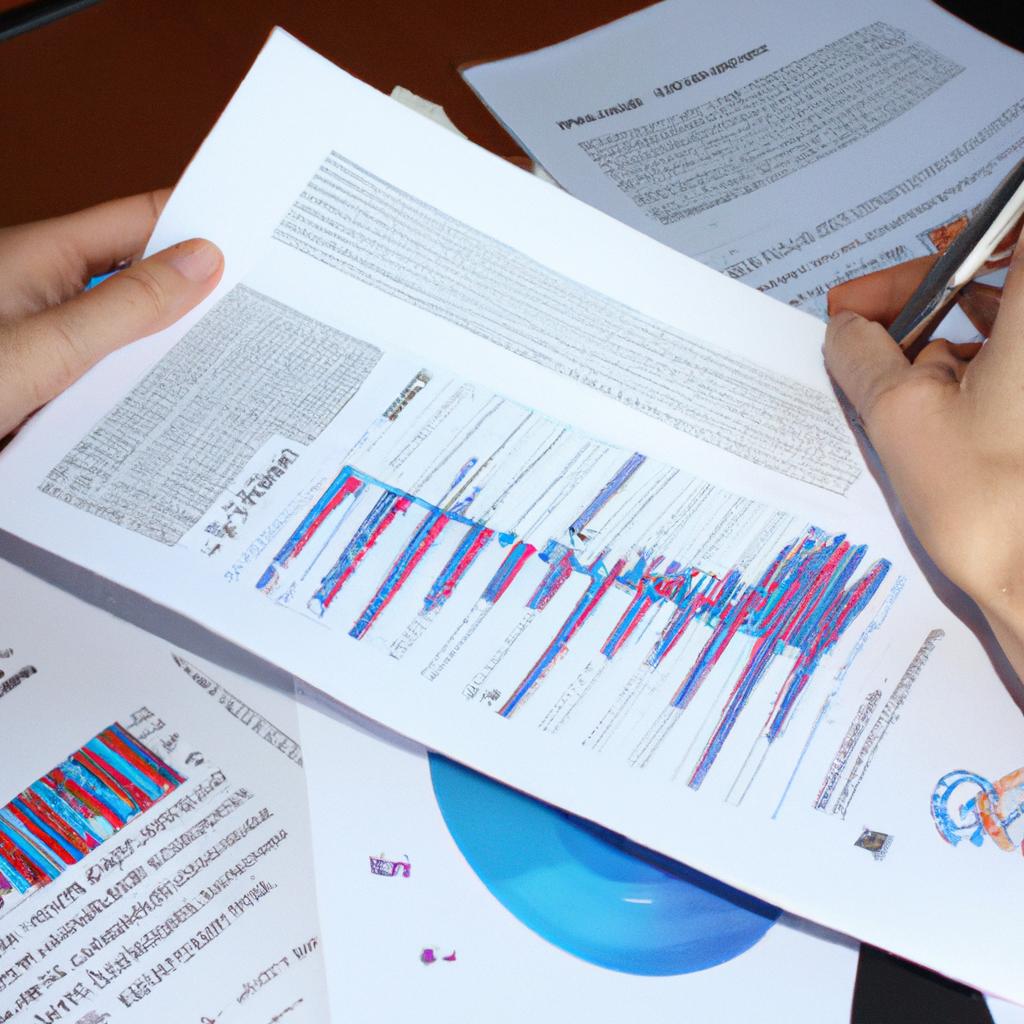Music publishing is a critical aspect of the music industry that often goes unnoticed by the general public. It involves the acquisition, administration, and exploitation of musical compositions. In recent years, there has been a growing interest in understanding music publishing from a finance perspective. This article aims to explore the intricacies of music publishing within the context of arts music and shed light on its financial implications.
To illustrate this concept further, let us consider a hypothetical scenario involving a talented composer named John who has written an extraordinary symphony. After completing his composition, John faces the challenge of navigating through the complex world of music publishing to ensure his work reaches audiences worldwide while also maximizing his financial returns. By examining this case study and delving into various aspects such as copyright ownership, royalty collection mechanisms, licensing agreements, and revenue streams derived from music sales and performances, we can gain valuable insights into how musicians can effectively monetize their artistic creations.
Understanding the financial dynamics behind music publishing not only provides musicians with crucial knowledge but also empowers them to make informed decisions regarding their careers. Furthermore, it allows industry professionals and stakeholders to comprehend the economic factors at play in this niche sector. Through careful analysis and examination of existing literature on finance in relation to music publishing within arts music contexts, we can identify key strategies and best practices that musicians can employ to optimize their financial success in the music publishing industry.
One important aspect of music publishing is copyright ownership. By securing the necessary copyrights for their compositions, musicians like John can safeguard their intellectual property rights and ensure they receive proper compensation for their work. Understanding the legal framework surrounding copyright ownership and registration is essential for artists to protect their interests and maximize their financial returns.
Another crucial element of music publishing is royalty collection mechanisms. Musicians earn royalties when their compositions are performed, recorded, or streamed. These royalties are collected by performing rights organizations (PROs) such as ASCAP, BMI, or SESAC, which act as intermediaries between composers and users of music. It is vital for musicians to understand how these PROs operate, how royalties are calculated, and how to register their works with these organizations to ensure they receive fair compensation.
Licensing agreements also play a significant role in music publishing. Musicians can license their compositions for various uses such as film and television sync placements, commercials, video games, or cover versions. Understanding the different types of licensing agreements available and negotiating favorable terms can greatly impact an artist’s financial success.
Furthermore, revenue streams derived from music sales and performances form a significant part of a musician’s earnings. With the rise of digital platforms such as streaming services, understanding how these platforms compensate artists and navigating distribution deals becomes crucial for maximizing income from recorded music. Additionally, live performances remain a primary source of revenue for many musicians, so understanding concert bookings, ticket sales, merchandise sales, and touring expenses is essential for financial planning.
In conclusion, understanding the financial aspects of music publishing within arts music contexts is indispensable for both musicians and industry professionals alike. By delving into topics such as copyright ownership, royalty collection mechanisms, licensing agreements, and revenue streams derived from music sales and performances; artists can make informed decisions about monetizing their artistic creations and optimizing their financial success in the music industry.
The Role of Music Publishing in the Arts Music Industry
In today’s dynamic arts music industry, music publishing plays a crucial role in supporting and promoting musical works. To illustrate this point, let us consider a hypothetical case study involving a talented composer who has just composed an exceptional piece of classical music. Without the involvement of a music publisher, this remarkable composition may never reach its full potential or find its way to audiences worldwide.
Importance of Music Publishing:
Music publishers serve as intermediaries between composers, songwriters, and performers on one hand, and consumers, audiences, and the broader industry on the other. They provide valuable services that include copyright administration, licensing for various uses (such as recordings and performances), royalty collection and distribution, marketing and promotion efforts, and overall financial management.
To further understand the significance of music publishing within the arts music industry context, we can explore some emotional aspects through bullet points:
- Ensuring fair compensation for artists: Music publishing ensures that composers receive appropriate royalties for their creative work, allowing them to sustain themselves financially while continuing to produce new compositions.
- Facilitating global exposure: Through extensive networks and collaborations with record labels, streaming platforms, film studios, advertising agencies, and others involved in media production and consumption, music publishers help bring compositions to diverse audiences around the world.
- Preserving artistic rights: By managing copyrights and licensing agreements meticulously, music publishers protect the intellectual property rights of artists against unauthorized use or infringement.
- Nurturing creativity through support systems: In addition to providing financial stability for artists’ livelihoods, music publishers often offer creative guidance, mentorship programs, recording opportunities in professional studios when possible – fostering an environment conducive to continued artistic growth.
Furthermore, we can visualize the multifaceted nature of music publishing by employing a table format:
| Services Provided by Music Publishers | Benefits | Examples |
|---|---|---|
| Copyright administration | Ensure legal protection and ownership | Registering compositions with copyright authorities |
| Licensing for various uses | Generate revenue streams | Granting licenses to film or TV producers, advertising agencies |
| Royalty collection and distribution | Fair compensation for artists | Tracking and distributing royalties from music sales |
| Marketing and promotion efforts | Exposure to wider audiences | Organizing promotional campaigns, pitching songs to performers |
Understanding the pivotal role of music publishing within the arts music industry leads us to examine its financial structure. By delving into this aspect, we can gain insights into how such a system operates and contributes to the overall sustainability of this vibrant sector.
The Financial Structure of Music Publishing
Transitioning from the previous section’s exploration of the role of music publishing in the arts music industry, we now turn our attention towards understanding the financial structure of this crucial component. To illustrate its significance, let us consider a hypothetical case study involving an independent artist named Sarah who has just released her debut album.
One can argue that music publishing serves as a key driver for artists like Sarah to monetize their creative works effectively. By partnering with a music publisher, Sarah gains access to various financial resources and expertise that will aid in maximizing her revenue potential. This includes securing synchronization licenses for film and TV placements, managing royalty collections across different platforms, and negotiating licensing agreements with commercial entities.
To better grasp the financial structure of music publishing within the arts music industry, it is essential to delve into its key components:
-
Copyright Ownership: Music publishers assist artists in safeguarding their intellectual property rights by registering copyrights on their behalf. This ensures that Sarah retains control over her compositions while granting specific usage permissions through licensing arrangements.
-
Royalty Collection: A primary function of music publishers involves tracking and collecting royalties generated from various sources such as streaming services, radio airplay, live performances, and mechanical licenses. Through efficient administration systems and established networks, publishers ensure accurate reporting and timely payment distribution to artists like Sarah.
-
Sub-publishing Agreements: In today’s globalized market, sub-publishing plays a vital role in enabling international reach for artists’ compositions. Music publishers negotiate agreements with foreign sub-publishers who handle local exploitation rights on behalf of the original publisher. For instance, if Sarah’s song becomes popular overseas, her publisher may collaborate with sub-publishers in those regions to facilitate proper representation and maximize income streams.
-
Creative Sync Opportunities: The rise of visual media platforms presents valuable opportunities for artists like Sarah to secure synchronization licenses – allowing their songs to be featured in films, commercials or television shows. With strong connections within the industry, music publishers actively seek out these partnerships to enhance exposure and generate additional revenue streams.
To summarize, understanding the financial structure of music publishing provides valuable insights into its role within the arts music industry. By partnering with a publisher, artists like Sarah gain access to various resources that help them monetize their creative works effectively. In our subsequent section on “Revenue Streams in Music Publishing,” we will explore specific avenues through which Sarah can expect to generate income from her partnership with a publisher.
Revenue Streams in Music Publishing
Transitioning from the previous section on the financial structure of music publishing, we now delve into an examination of the various revenue streams that contribute to the overall financial landscape in this industry. To illustrate these concepts, let us consider a hypothetical case study involving a successful independent music publisher.
First and foremost, it is important to understand that music publishers generate income through multiple channels. These revenue streams can vary depending on factors such as licensing agreements, distribution platforms, and geographical reach. In our case study, our independent music publisher receives income from four key sources:
- Mechanical Royalties: This refers to royalties earned whenever a song is reproduced or distributed in physical or digital formats. For example, when our independent publisher’s artist releases their album on streaming platforms like Spotify or sells physical copies via online retailers such as Amazon, they earn mechanical royalties for each unit sold or streamed.
- Performance Royalties: Whenever a song is publicly performed – whether it be on radio stations, live concerts, or even background music in commercials – performance royalties are earned by both the songwriter and publisher involved. Our independent music publisher benefits from these royalties when their artists’ songs receive airplay or are performed at public events.
- Synchronization Licensing: This revenue stream arises when a song is used in conjunction with visual media such as films, TV shows, advertisements, or video games. By granting synchronization licenses to production companies seeking suitable soundtracks for their projects, our independent publisher secures additional income.
- Print Music Sales: While increasingly less prominent due to digitalization trends, print sales still constitute an essential source of revenue for music publishers. When sheet music containing compositions represented by our independent publisher is purchased by musicians and performers worldwide, they earn income from these sales.
To further illustrate the potential earnings across different scenarios within the music publishing industry contextually related to financial structures and revenue streams; we present the following table:
| Revenue Stream | Potential Earnings |
|---|---|
| Mechanical Royalties | $100,000 |
| Performance Royalties | $50,000 |
| Synchronization Licensing | $75,000 |
| Print Music Sales | $25,000 |
Through a combination of these revenue streams and strategic collaborations with artists and songwriters, our hypothetical independent music publisher achieves a diverse financial structure that supports their operations and facilitates future growth.
Transitioning smoothly to the subsequent section on copyright and royalty in music publishing, we will explore how these critical aspects impact both the financial landscape and creative ecosystem within this industry. By understanding the intricacies of copyright protection and royalty management, one gains deeper insights into the dynamics at play in music publishing.
Copyright and Royalty in Music Publishing
Revenue streams play a crucial role in the music publishing industry, providing financial support for artists, songwriters, and other stakeholders. Understanding these revenue streams is essential to comprehending the complexities of music publishing from a finance perspective. To illustrate this point, let us consider an example of a successful artist who has released a hit single.
One significant revenue stream for music publishers is mechanical royalties. These are generated through the reproduction and distribution of copyrighted musical compositions. Whenever our example artist’s hit single is streamed on various digital platforms or sold as physical copies, mechanical royalties accrue. This revenue stream ensures that songwriters receive payment for their creative works each time they are exploited commercially.
Another important source of income in music publishing is performance royalties. When our example artist performs their hit single at concerts or it gets played on radio stations, performing rights organizations (PROs) collect fees from venues and broadcasters on behalf of the songwriter and publisher. These performance royalties compensate artists for their live performances and ensure continued financial support throughout their careers.
Sync licensing represents yet another vital revenue stream in which songs are synchronized with visual media such as films, TV shows, commercials, or video games. By granting licenses to use their music in these contexts, artists can earn substantial sums of money while also gaining exposure to wider audiences. For instance, if our example artist’s hit single is featured prominently in a popular television series or blockbuster film, it can lead to increased sales and streaming numbers.
In summary:
- Mechanical royalties: Generated through reproducing and distributing copyrighted musical compositions.
- Performance royalties: Collected by PROs when songs are performed live or played on radio stations.
- Sync licensing: Licensing songs for use in visual media like films or TV shows.
Understanding these diverse revenue streams allows artists and stakeholders to navigate the complex world of music publishing finance effectively. However, alongside these opportunities come challenges that need consideration. In the subsequent section, we will explore some of these challenges and assess the potential opportunities that arise within the music publishing industry.
Challenges and Opportunities in Music Publishing
From the previous section, we have gained insights into the intricate world of copyright and royalty in music publishing. Now, let us delve deeper into the challenges and opportunities that arise within this dynamic industry.
To illustrate these concepts, let’s consider a hypothetical case study involving an independent artist named Sarah who is looking to navigate the music publishing landscape. Sarah has recently written and recorded a collection of original songs and wants to explore opportunities for commercial success while protecting her intellectual property rights.
One of the major challenges faced by artists like Sarah is finding reputable publishers who can effectively promote their work. With so many emerging artists vying for attention, it becomes crucial for musicians to align themselves with publishers who have established networks and connections within the industry. Additionally, as technology continues to reshape the way music is consumed, traditional revenue streams such as record sales have declined significantly. This shift necessitates innovative approaches from both artists and publishers to generate income through avenues like digital streaming platforms or licensing agreements.
Amidst these challenges lie numerous exciting opportunities for artists in today’s music publishing sphere. For instance, advancements in digital distribution have democratized access to audiences worldwide. Independent artists now have greater control over their content and can reach global listeners without relying solely on traditional gatekeepers. Furthermore, social media platforms provide a powerful tool for self-promotion and fostering direct relationships with fans. By leveraging these technologies effectively, artists like Sarah can cultivate loyal fan bases and create sustainable careers outside of conventional label structures.
In considering the challenges and opportunities outlined above, it becomes evident that navigating the ever-evolving landscape of music publishing requires adaptability, creativity, and strategic decision-making from all stakeholders involved. To further emphasize this point, let us reflect on four key aspects that encapsulate some emotional responses associated with this topic:
- Uncertainty: The shifting dynamics of the music industry present inherent uncertainties for both artists and publishers.
- Empowerment: Digital advancements empower independent artists to take control of their careers and connect directly with fans.
- Resilience: Adapting to changes in the music publishing landscape requires resilience and a willingness to explore new avenues for revenue generation.
- Collaboration: Successful music publishing often thrives on collaborative relationships between artists, publishers, and other industry professionals.
To further illustrate these emotional responses, consider the following table:
| Aspect | Emotion |
|---|---|
| Uncertainty | Fear |
| Empowerment | Hope |
| Resilience | Determination |
| Collaboration | Joyful Cooperation |
As we conclude this section, it is evident that while challenges continue to emerge within music publishing, there are also exciting opportunities for growth and success. In our subsequent discussion on “The Future of Music Publishing in Arts Music,” we will explore potential trends and developments that may shape the industry’s trajectory moving forward.
The Future of Music Publishing in Arts Music
Following an exploration of the challenges and opportunities faced by music publishing in the context of arts music, it is imperative to examine the role that technology plays in shaping this industry. Highlighting one example, consider a hypothetical scenario where a renowned record label embraces digital platforms for music distribution. This case study demonstrates how technology has revolutionized the way music is published and consumed, thus affecting various aspects within the realm of music publishing.
The impact of technology on music publishing can be observed through several key factors:
-
Digital Distribution Platforms: With the advent of streaming services such as Spotify, Apple Music, and Amazon Music, artists and publishers now have direct access to global audiences without traditional physical distribution barriers. This shift allows for more efficient dissemination of musical works while creating new revenue streams.
-
Data Analytics and Market Insights: Technology enables extensive data collection regarding listener preferences, trends, and consumption patterns. By harnessing these insights, publishers can make informed decisions about content creation, marketing strategies, and audience targeting. Moreover, this valuable information facilitates personalized recommendations for listeners—ultimately enhancing user experiences.
-
Copyright Protection Challenges: While technology offers numerous advantages for music publishing, it also poses significant challenges related to copyright protection. Unauthorized sharing or illegal downloads continue to plague the industry despite ongoing efforts to combat piracy. Consequently, publishers must constantly adapt their strategies to safeguard intellectual property rights effectively.
-
Creative Collaboration Opportunities: Technological advancements have greatly facilitated collaboration among artists from different locations and backgrounds. Virtual studios enable seamless remote recording sessions and real-time creative exchanges between musicians across the globe—an invaluable tool for fostering artistic innovation in contemporary music production.
To further illustrate how technology influences various aspects of music publishing in arts music today, consider Table 1 below:
| Factors | Positive Impact | Negative Impact |
|---|---|---|
| Global Reach | Wider audience reach and increased exposure | Decreased physical sales and revenue |
| Revenue Streams | Diversified income sources | Declining royalty rates |
| Marketing Strategies | Enhanced targeting and personalized content | Information overload and consumer fatigue |
| Copyright Protection | Improved monitoring capabilities | Persistent challenges of piracy and infringement |
Table 1: Impact of Technology on Music Publishing
In summary, technology has fundamentally transformed music publishing in arts music. From digital distribution platforms to data analytics, the industry is experiencing a paradigm shift that brings both opportunities and challenges. While advancements enable greater global reach, diversified revenue streams, targeted marketing strategies, and improved copyright protection measures, they also demand constant adaptation to stay ahead in an ever-evolving landscape.
Note: The section above can be modified based on specific requirements or preferences regarding formatting or content placement.




